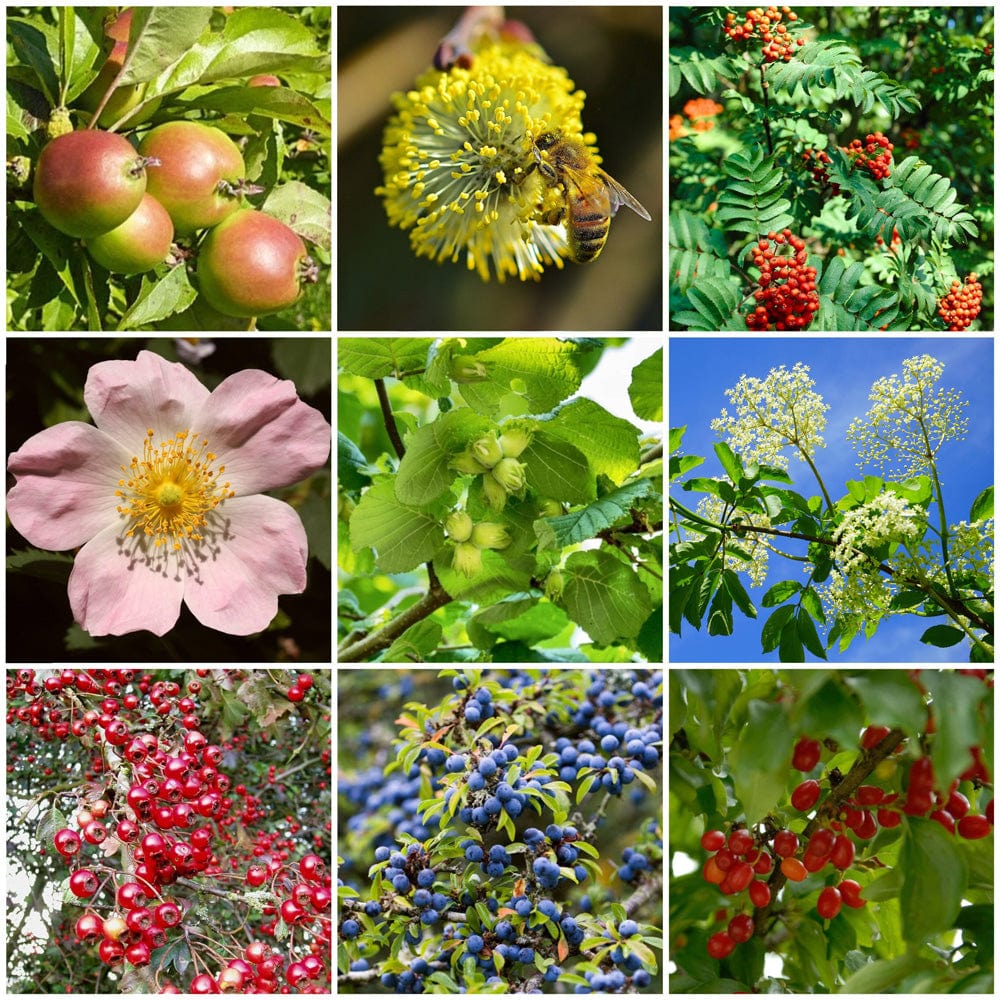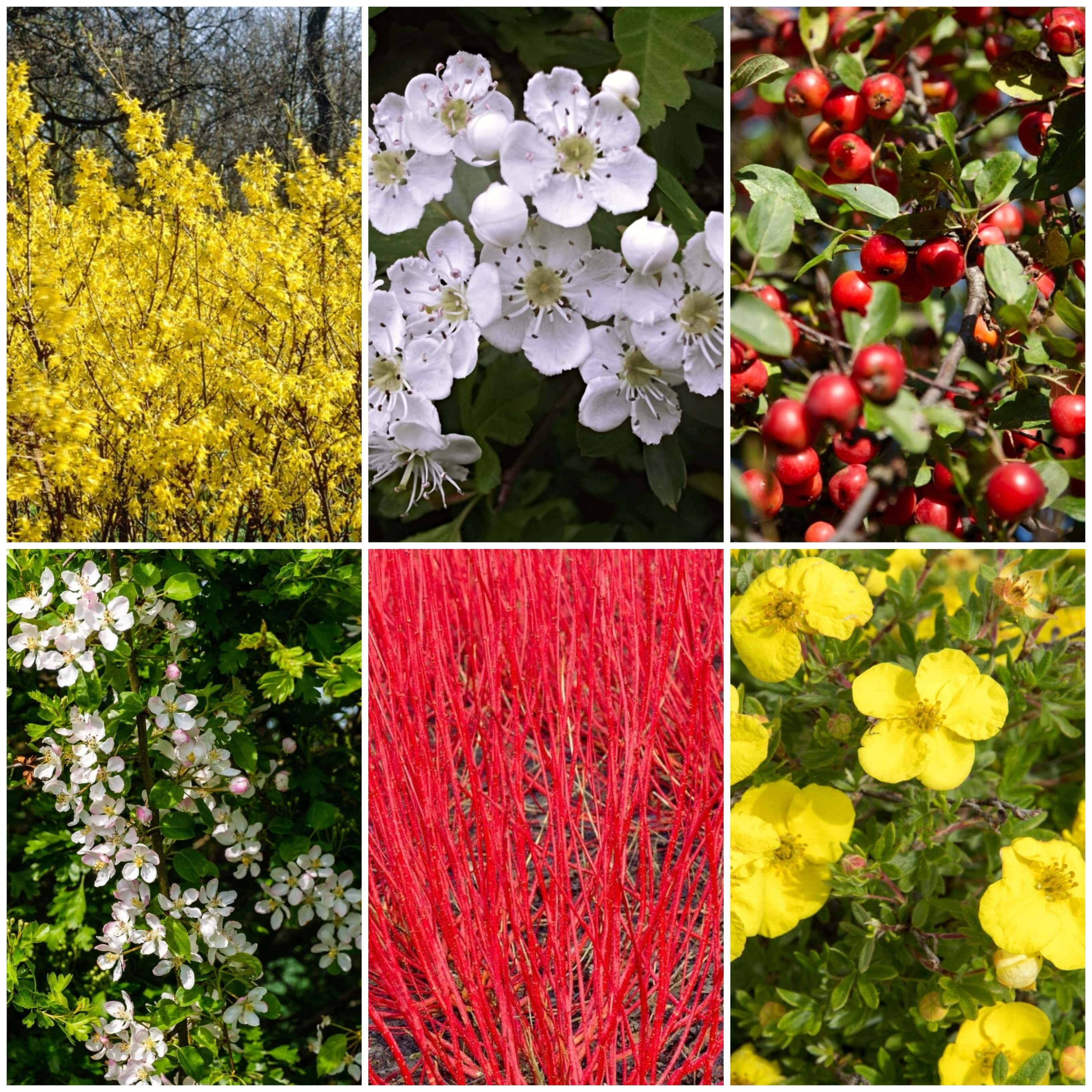Advice & Inspiration
Rowan Tree Problems: Grower’s Care Guide

Rowan trees are generally very easy going, hardy trees which present very few problems. Plant them in a favourable position, water them well and keep them pruned – that’s usually all the care you’ll need to do. As a native UK species, the rowan has adapted to some pretty severe weather conditions and is well equipped to deal with pests and diseases.
What doesn’t kill you makes you stronger, right? But occasionally, even the toughest trees can go wrong. Read on to find out about problems that can affect your rowan tree, how to detect them and how to fix them – or even better, avoid them altogether.
Jump to:
- Rowan tree care
- Rowan tree with brown leaves
- Rowan tree with no flowers
- Rowan tree with no berries
- Fire blight
- Crown gall
- European Mountain Ash Ringspot Associated Virus (EMARAV)
- Cytospora canker
- Honey fungus
- Silver leaf fungus
- Coral spot
- Aphids
- Sawflies
- Scale insects
- Red spider mites
Rowan tree care
The best place to plant a rowan tree is in a position with full sun or partial shade and a well drained soil. When your tree is young, make sure you water it regularly to help it put down a good solid root system, then give it a feed with a general purpose fertiliser every spring. Rowan pruning should only be done when the tree is dormant from November to March.
While you’re pruning, give your rowan a good once over to check for any signs of pests or diseases. You probably won’t find any, but if you do, early detection means you can sort the problem out while it’s still manageable. Here’s our one stop rowan tree troubleshooting guide.

Rowan tree with brown leaves
If you find your rowan tree’s leaves are turning yellow or brown, or crinkling up, it’s probably due to a lack of water. You can avoid this by planting it in moist, well-draining soil and keeping it watered well for the first three years after planting.
Rowans are UK native trees which, as you can imagine, are not used to dealing with long spells of hot, dry weather. They also have relatively shallow root systems, so if we do get a very hot summer, you’ll need to step up to daily watering to make sure your tree doesn’t dry out. If your tree is well watered but still has brown leaves, it could be a sign of fungal disease. Stay vigilant.

Rowan tree with no flowers
Rowan trees usually flower in late May or early June, so if yours isn’t blossoming by then, there are a few things you can do to help it along. Make sure your tree is getting enough sun, water and nutrients – if you haven’t given it any fertiliser recently, one that’s high in potassium (potash) will encourage flower production.
The problem may be that a late spring frost damaged the developing flowers (unlucky) or that spring pruning has cut off some of the flower buds (a lesson learned for next year). Sometimes, though, the tree is just too young to have started flowering, or local weather conditions mean that the blossom is delayed this year.
You can check this last possibility by looking at other rowan trees in your area to see if they’re blooming yet. If you have a very young tree, be patient – depending on the variety, they might take a year or so to really get going, but I promise it’ll be worth the wait when they do!

Rowan tree with no berries
Rowan berries normally start to develop right after flowering has finished. They ripen throughout the summer and are fully coloured up by late summer or early autumn. If your tree hasn’t got any berries by summer, again it’s most likely to be that your young tree just isn’t ready for that stuff yet.
All of our rowan trees are grafted, so will fruit many years before those grown from seed, but you still may have to be a little patient. What can you do to help it along? Give your tree a potassium-rich feed, as this encourages both flowering and fruiting. Make sure it’s well watered, has enough sun and seems healthy in every other way.
Some trees have the annoying habit of going biennial – this means that they produce a lot of fruit one year and very little the next. The cause could also be, as in the case of flowers, a frost or some overzealous pruning. Again, it may be reassuring to check other rowans in your area, as it might just be the weather conditions affecting them.

Rowan tree diseases
Researching tree diseases is a bit like googling your symptoms. You could indeed be doomed, but it’s far more likely that there’s a simpler explanation. In tree terms, most problems can be solved by adjusting the growing conditions or doing a bit of pruning.
So, think of this as a list of worst case scenarios; the alarming side effects leaflet in your packet of paracetamol. Rowan trees are amongst the most robust, disease-resistant trees out there and some of these diseases are pretty rare, so chances are you’ll never have to think about them, but hey, knowledge is power. Don’t touch that keyboard.
Fire blight
A bacterial infection that can affect any tree, fire blight lurks from spring to early autumn. It can get into the tree via rain, wind, pruning or the tree’s flowers.
What it looks like
Fire blight causes wilted or dead blossoms, white ooze coming from infected parts of the tree in wet weather, shrivelled, dying shoots and cankers (areas of sunken, dead wood that looks like it’s been burned – hence the name).
What’s the damage?
If left unchecked, fire blight can spread throughout the whole tree, turning shoots, leaves and branches brown, before they shrivel up.
How to fix it
You can avoid fire blight simply by pruning at the right time of year – late winter to early spring, while the tree is dormant – and only on a dry day so rain doesn’t get into the fresh pruning cuts. Early detection can stop fire blight spreading, so check your rowan regularly.
If you do see signs, cut out the affected branches and dispose of them by burning or in the black bin, then sterilise your tools before using them on any other trees.
Crown gall
This is a soil-borne bacterial disease which gets into trees via exposed wounds in the lower parts of the tree.
What it looks like
If your tree has crown gall, you’ll see large, swollen growths (galls) on any part of the trunk or branches.
What’s the damage?
Young trees are more vulnerable to this than established rowans; in fully grown trees, crown gall is more ugly than dangerous, but it can stop a young tree from growing properly. As well as this, it can weaken the tree, making it easier for other infections to gain a hold.
How to fix it
If your tree has crown gall, you should prune out all of the infected branches and dispose of them by burning or in the landfill bin. Do this on a dry, cold day while the tree is dormant and sterilise your tools after use. If the trunk is infected and the tree is obviously suffering, then unfortunately the outlook is a bit bleaker: you’ll probably have to cut your losses and remove the whole tree.
European Mountain Ash Ringspot Associated Virus (EMARAV)
This snappily-named condition is a fairly new addition to the ranks of tree diseases, with cases being seen throughout Europe and Northern parts of the UK.
What it looks like
The leaves of affected trees develop pale green patches and mottling in ring patterns. The tree itself will grow more slowly than usual and look generally sad.
What’s the damage?
The virus slows down the tree’s growth and eventually kills it.
How to fix it
Research is still ongoing to find a treatment for EMARAV, and we don’t yet know enough about it to recommend a treatment. It is a notifiable virus though, so if you do suspect your tree has it, you’ll need to report it via TreeAlert (UK) or TreeCheck (ROI).
Cytospora canker
There are many variations of canker which affect different trees, and unfortunately rowan is no exception. This airborne fungus infects the trunk and branches, entering via damaged bark.
What it looks like
Sunken patches of dead bark appear on the branches or trunk - sometimes these will ooze sap.
What’s the damage?
Your tree’s new growth may die back or never even appear. If the infection spreads, whole branches can die and ultimately the whole tree.
How to fix it
You can prevent canker by only pruning when the tree is dormant, and only on a dry day, with clean sharp tools. Try not to let anything damage the surface of the bark, such as cat scratches or accidentally bumping it with the strimmer.
If your tree is affected, cut out all of the cankered parts of the tree – do this job on a cold, dry day to avoid any infection getting into the new pruning cuts. Sterilise your tools afterwards and dispose of the cuttings in landfill waste or by burning.
Honey fungus
A fungal infection that spreads underground via the root-like rhizomorphs of the fungus itself and through infected tree roots.
What it looks like
This one looks like a white fungal growth that smells of mushrooms and not in a good way. It starts at ground level and works its way up.
What’s the damage?
Honey fungus attacks the roots and base of the trunk, spreading upwards and slowly weakening, then killing the tree.
How to fix it
Alas, there’s no actual cure for this one, so prevention is the best option. Make sure you plant your tree in well draining soil with plenty of airflow around the base - pruning out any low growing shoots and pruning to keep a nice open shape can help.
If you do get honey fungus then unfortunately you’ll have to remove the tree altogether and break up the soil afterwards, to get rid of any lurking rhizomorphs.
Silver leaf fungus
An airborne fungus that gets in via wounds in the tree’s bark, then spreads through the sap.
What it looks like
If you spot a silver sheen on your tree’s leaves it could be silver leaf. However it could also be frost damage, so if the other sign (decaying wood) isn’t there, you’re probably OK.
What’s the damage?
This fungus can spread throughout the tree, causing the wood to rot and eventually killing the tree if it’s not treated early.
How to fix it
You can prevent silver leaf by careful pruning: always prune on a dry day when the tree is dormant, remove any branches that are rubbing together or crossing and sterilise your tools before and after pruning
If you do detect silver leaf, cut out all the infected parts of the tree – you’ll need to do this on a dry day to avoid the cuts getting infected. If too much of the tree is affected, you may unfortunately have to remove it altogether.
Coral spot
A fungal disease which is kind of pathetic in itself, but can affect trees which have already been weakened by other infections.
What it looks like
Parts of the wood die, then coral pink, raised spots appear on it.
What’s the damage?
Coral spot can often be a warning sign that you need to check your tree for other infections, as it’s unlikely to occur in isolation. As well as looking ugly, however, it can attack the weakened parts of the tree and cause them to die back.
How to fix it
Cut out any infected parts of the tree promptly, then dispose of the pruned branches in your garden waste ASAP, rather than letting them sit around generating more spores. If you catch it early, the tree can often recover.
Rowan tree pests
Rowan trees are friends of wildlife, typically supporting around 30 insect species. When they do get targeted by insects we regard as pests, they’re rarely bothered and most small infestations can be left alone. Soon there’ll be a predator along to take care of them for you! However, if there is an imbalance and you get a particularly heavy onslaught, here’s how to deal with them.
Aphids
Aphids are sap sucking insects that are also known as greenfly or blackfly.
What they look like
Aphids are little green or brown insects (1-7mm long) which cling to flower buds, shoots and under leaves.
What’s the damage?
They suck the sap out of green shoots, leaves and stems, causing stunted growth, and excrete a sticky ‘dew’ that encourages mould.
How to get rid of them
Small numbers of aphids shouldn’t be a problem, as there will be plenty of ladybirds, hoverflies and other predators around to deal with them for you. If their numbers increase to a level you’re uncomfortable with however, you can a) squash them (gross) b) spray the affected parts of the tree with soap/oil sprays or encourage those predators by planting their favourite foods, such as marigold, tansy and fennel nearby.

Sawflies
There are lots of different insects that come under this category, but what they have in common is the saw-like mouthparts that they use to cut into leaves.
What they look like
You may spot the larvae on leaves in summer, looking like green or grey caterpillars depending on the kind of sawfly. If you don’t, you’ll certainly see their handiwork when your leaves get eaten.
What’s the damage?
Sawflies can eat holes in your tree’s leaves, sometimes leaving only the veins intact. Although this looks bad, it doesn’t usually affect the overall health of the tree, although younger trees are more vulnerable.
How to get rid of them
To be honest, you probably don’t need to bother. The natural sawfly predators attracted by the rowan tree (birds, wasps and ground beetles) will likely take care of the sawflies, and in any case the damage they cause is only really cosmetic.
If you do want to get rid, however, check under the leaves in spring and early summer, and remove any clusters of eggs you find.
Scale insects
What is it with that rowan sap and why are these insects so thirsty for it?
What they look like
‘Scale insects’ is an umbrella term for a wide range of beasties, ranging from 1mm-1cm in size. They all leave scale or shell-like bumps on stems and under leaves.
What’s the damage?
High levels of scale insect activity can stunt the growth of your tree, especially if it’s young. Some species also excrete honeydew, which can lead to black mould developing.
How to get rid of them
As with the aphids, you can usually get on top of this by spraying with soap/oil sprays or encouraging predators (birds, ladybirds and parasitoid wasps). If that doesn’t work, you can try the nematode Steinernema feltiae, which can be bought online.
Red spider mites
These badly named critters usually hang out in greenhouses, but they can also be seen in the garden in summer.
What they look like
Another sap sucking insect, this one is not actually red (apart from in autumn and winter, when you probably won’t see any) - it’s a tiny, yellow-green bug with two dark patches on its back. It tends to lurk on the underside of leaves, or you might see a fine webbing on your tree.
What’s the damage?
Large populations of these mites can cause the leaves to drop or look mottled, and in severe cases they can kill parts of the tree.
How to get rid of them
A few red spider mites can safely be ignored. If they start to become a problem however, you can get rid of them by bringing in predators like the mite Phytoseiulus persimilis, the midge Amblyseius (Feltiella acrarsuga) or the Atheta coriaria beetle, which can be bought online.
That’s a lot of problems… Should I be worried?
There are a lot of worst case scenarios here, but for the vast majority of rowan tree owners, none of these hideous diseases and troublesome pests will ever put in an appearance.
However, forewarned is forearmed! Keep an eye on your tree, act fast if a problem arises and you’ll be enjoying your beautiful tree for decades to come. After all, rowans have been growing in the UK since the ancient Celts roamed the land, so it’s probably safe to say they’re a pretty resilient bunch.



















